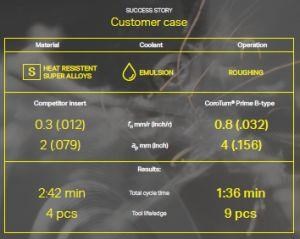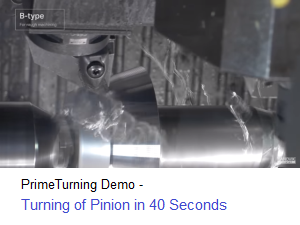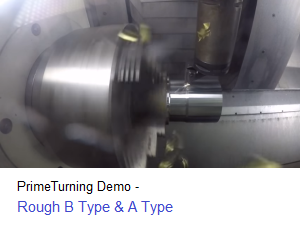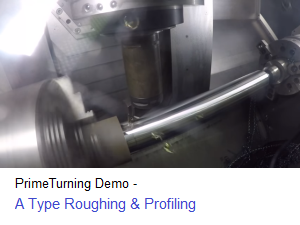All-Directional Turning Cuts Cycle Times 50%
Sponsored ContentSandvik Coromant’s PrimeTurning process allows turning and facing in all directions, delivering dramatic increases in high volume production. Cycle time reductions of 50% or more can be achieved.
Share
If you thought there’s nothing new in turning, think again. Sandvik Coromant’s new PrimeTurning process offers dramatic improvements over conventional turning, allowing higher speeds and feeds, better chip control, improved tool life, and less time lost cutting air.
We’ll explain more below, but first take a look at this video and you’ll get the picture quickly.
No, the video is not running backwards on some of those cuts. In conventional turning, you feed toward the chuck in the Z axis. But with PrimeTurning you can feed in either direction in turning, facing and shoulder-cutting operations. The results are astonishing. Some operations can be performed in a small fraction of the time required in conventional turning, and with a better surface finish as well.
A Very Different Insert
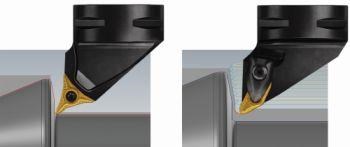
The A-type insert (left) is for light roughing,
finishing and profiling. The B-type insert is
for roughing.
The CoroTurn Prime inserts come in two configurations. The A-type insert is designed for light roughing, finishing and profiling. With extremely strong corners, the B-type insert is for roughing. A key benefit of their designs is a smaller lead angle relative to the feed direction which allows you to cut substantially faster. This approach spreads cutting forces and heat over a larger portion of the cutting edge, which also contributes to longer tool life.
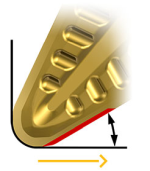
For some operations, you can literally feed back and forth with the tool virtually never leaving the cut. That’s a huge time-saver particularly in roughing operations requiring multiple passes to get down to the required OD.
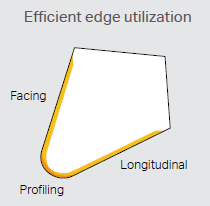
Turn, face or profile
with a single tool.
Another advantage of the low lead angle (25% for Type B, 35% for Type A) is that it creates a wiper-like action that leaves a better surface finish. That’s particularly advantageous in roughing because it also leaves less work to do in subsequent finishing cuts.
Still another advantage of the insert shape is the ability to use the entire edge of the insert, and for a variety of operations. You can turn, face or profile with a single tool. That’s more life from an insert. Better yet, it can eliminate multiple tool changes required with less versatile inserts.
Thinking Different About Process
It’s one thing to have these capabilities, but quite another to use them wisely. To that end Sandvik Coromant has online help on how to use CoroTurn Prime tools and the kinds of parts that best lend themselves to the process. In general, the best candidates are short and compact components in chucking applications and longer components with a tailstock.
View Videos
- Turning Re-Invented – PrimeTurning™ and CoroTurn® Prime
- PrimeTurning demo – Turning of Pinion in 40 Seconds
- PrimeTurning demo – Rough B Type and A Type
- PrimeTurning demo – A Type - Roughing / Profiling
To make the most of the PrimeTurning process you really have to think differently about the cutting strategy because conventional wisdom does not apply. Indeed, that’s the point, because PrimeTurning unlocks the door to much more productive cutting routines. That’s also going to require a new approach part programming, and CAM systems are going to have to catch up to best practices for the process.
To bridge the gap, Sandvik Coromant has developed a PrimeTurning code generator that allows for smooth implementation of the most productive cutting strategies for the process. The easy-to-use software allows several ways to input a turned profile. You can copy-paste existing code, describe the profile with a G71 cycle, or draw the profile in visual mode. The software will then output a new routine in an ISO-compatible format.
But help from CAM vendors is not far off. Mastercam is already in beta test for its next release which the company has announced will support the PrimeTurning method.
Is PrimeTurning For You?
The more metal you are removing on a part, the more benefit you’ll get from PrimeTurning. Included in the Infographic here is but one example where the process resulted in an 85% increase in productivity.
As for your parts, you can take a test on Sandvik Coromant’s website to see projected productivity improvements for different kinds of parts, materials, and clamping scenarios.
Is PrimeTurning for everyone? Not necessarily, or at least not yet. Because of the much more aggressive cutting parameters, you won’t want to use it on thin, vibration-prone parts or less stable workholding configurations. But for the parts that do apply, PrimeTurning can dramatically increase productivity in ways that were unthinkable before the advent of this process. Large volume manufacturers are likely to see the greatest benefits for now. Early adopters are going to be people who already well understand turning, and are looking for something more. For those shops, PrimeTurning is poised to offer more than they ever imagined.
